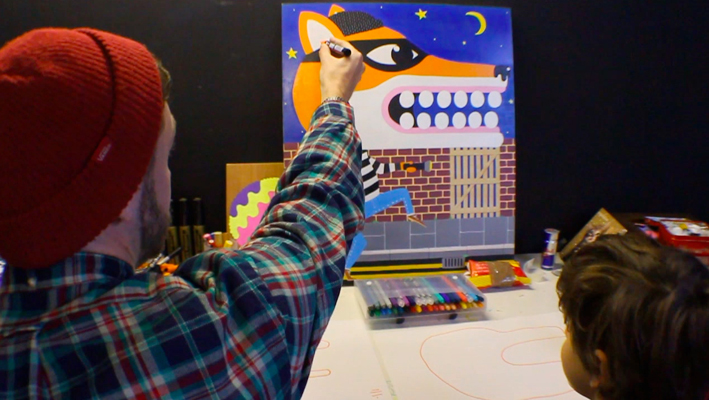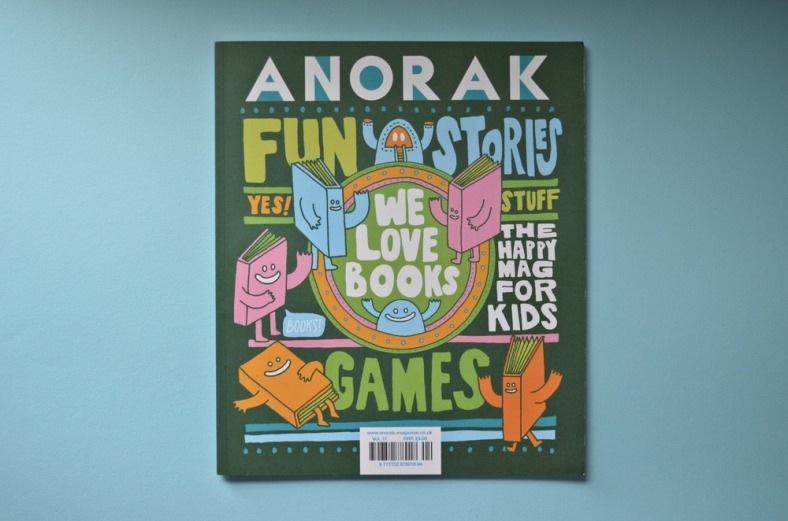In the Dylan Moran-starring sitcom Black Books two of the lead characters, in one episode, proclaim they could write a childrens’ book and make a fortune without breaking a sweat. Bill Bailey’s character claims he’ll write a book which kids will want to read, and watch the film, play the game and eat the branded yoghurts. By the end of the episode the two characters are reduced to inane yelling. Like every episode, really.
The Anorak Press, a London publishing company, may not have their own branded yoghurts yet, but they’re certainly on their way. They were founded by Cathy Olmedillas, an artist and designer formerly working for iconic 90s youth magazine The Face. Clearly the company has a strong head on its shoulders, one that is used to approaching a younger demographic. However, teenagers and children are in completely different worlds – Anorak had to approach children in a new and unique way to gain any interest. 7 years of successful publishing of childrens’ books suggests the company is doing something right.
It’s essential for a company, particularly a publisher, to understand their audience. For Anorak, however, this is so much easier said than done. No matter how quirky and immature most artists can be (not speaking from personal experience at all) it’s something altogether different trying to step into a kid’s shoes. Moreover aiming at children in general is too vague. What age range to aim at? As something suited for a 4-year-old and given to an 11-year-old will be thrown away in mere seconds.
The publisher’s main product, and magazine simply titled Anorak, is aimed at children ages 6 to 12. Different products appeal to different ages, and the open creativity-friendly magazines act more like blank canvases and starting points for activities, a structure which almost definitely appeals to more kids of more ages. They tend to draft in illustrators with bright and vivid colour palettes and simple and bold form to their style, almost as if a child’s own drawing wouldn’t look out of place alongside the illustrations in the book. It’s a clever approach and it gives Anorak’s work a distinct look and feel.
Their branding tends to focus on the word happy a lot, though I’m not totally convinced by it. Telling kids something is happy seems almost suspicious, like behind the office doors of Anorak all the illustrators are secretely mopey and crying. Once again, though, this is branding aimed at children – maybe it’s exactly the right thing. However this company seem to thrive on creatively inclined parents buying into the brand rather than the children. Quite like Toca Boca, Anorak seem to appeal to both parties, but in different places. The issue is that the ‘educational’ label sometimes looms over the brand rather monolithicly, and it can be off-putting for kids. It makes the whole process feel like work, unlike Toca Boca’s focus on play.
But after 7 years what changes have their been? Anorak is moving with the times. Print isn’t dead, but apps are a hell of a lot more lively, and Anorak’s own app, released in late 2011, shows this off nicely.
In June of this year Anorak took launched their next venture – a 20-minute show on YouTube titled Happy TV. Directed by Cathy Olmedillas herself the show runs on a low-budget, focusing more on filmed footage than animation. The signature Anorak look is there, with the simplest, most geometric character designs taking the forefront, for ease of animation. Some of the segments are quite clever ideas. Connecting children with professionals in the creative industry is the perfect demonstrator that it’s a viable thing to want to be. It carries all the excitement that meeting a policeman or firefighter does. Though hopefully the kids aren’t in circumstances to meet either. But I digress.
The show is, however, mixed in who it’s aimed at. Some sections, such as one where coloured shapes combine to show how colour combinations work feels aimed at really young kids, simply through it’s execution (“I am a blue circle, I am cool and round.” Like BB King?) The cooking segment, though, seems perfect for kids older, maybe around 10 or so. Mixing these sections is a big mistake. On top of this the pace of the whole show feels akward and stilted. The show has only run for one episode, so it could be teething problems, but whether this will take off at all is hard to say.
You can’t deny though that Anorak is doing something right. They’ve expanded to France and the US, and in an interview Cathy Olmedillas said that parents buy the first issue, whereas kids ask for every issue after that. I love the themed issues they run, like food or inventions, and it’s these triggers that kids need to set their imaginations going.
Listening to: Gold Livin by Shakeem X


